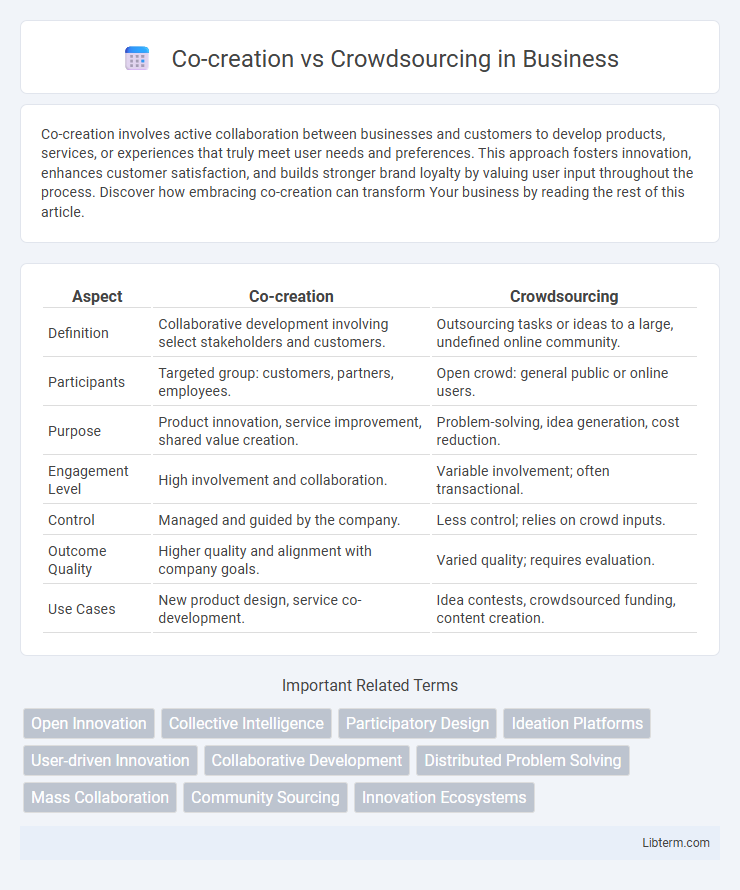Co-creation involves active collaboration between businesses and customers to develop products, services, or experiences that truly meet user needs and preferences. This approach fosters innovation, enhances customer satisfaction, and builds stronger brand loyalty by valuing user input throughout the process. Discover how embracing co-creation can transform Your business by reading the rest of this article.
Table of Comparison
| Aspect | Co-creation | Crowdsourcing |
|---|---|---|
| Definition | Collaborative development involving select stakeholders and customers. | Outsourcing tasks or ideas to a large, undefined online community. |
| Participants | Targeted group: customers, partners, employees. | Open crowd: general public or online users. |
| Purpose | Product innovation, service improvement, shared value creation. | Problem-solving, idea generation, cost reduction. |
| Engagement Level | High involvement and collaboration. | Variable involvement; often transactional. |
| Control | Managed and guided by the company. | Less control; relies on crowd inputs. |
| Outcome Quality | Higher quality and alignment with company goals. | Varied quality; requires evaluation. |
| Use Cases | New product design, service co-development. | Idea contests, crowdsourced funding, content creation. |
Understanding Co-Creation: Definition and Key Concepts
Co-creation involves active collaboration between businesses and their customers or stakeholders to jointly develop products, services, or experiences, emphasizing mutual value creation and shared innovation. Unlike crowdsourcing, which primarily gathers ideas or solutions from a large, often anonymous group, co-creation fosters deeper engagement, continuous dialogue, and co-development throughout the entire process. Key concepts of co-creation include trust-building, iterative feedback loops, empowerment of participants, and leveraging diverse perspectives to enhance creativity and market relevance.
What is Crowdsourcing? A Comprehensive Overview
Crowdsourcing is a strategic approach that leverages the collective intelligence and skills of a large, diverse group of people, often via online platforms, to solve problems, generate ideas, or complete tasks efficiently. This method taps into external contributors, ranging from experts to everyday users, to access a wide range of knowledge and creativity beyond an organization's internal resources. Key applications of crowdsourcing include innovation challenges, market research, content creation, and software development, driving cost-effective and scalable solutions.
Core Differences Between Co-Creation and Crowdsourcing
Co-creation involves active collaboration between a company and a select group of stakeholders or customers to jointly develop products, services, or content, emphasizing shared creativity and long-term engagement. Crowdsourcing taps into a broad, often undefined group of external contributors to solve problems or generate ideas, focusing on volume, diversity, and rapid input without necessarily fostering ongoing relationships. The core difference lies in co-creation's deeper partnership and shared ownership versus crowdsourcing's open call for contributions with limited participant involvement in the final outcome.
Benefits of Co-Creation in Modern Business
Co-creation enhances customer engagement by involving users directly in product development, leading to solutions that better align with market demands and increase brand loyalty. It fosters innovation through collaborative idea exchange between businesses and consumers, accelerating the creation of unique, competitive offerings. Co-creation also reduces risk by validating concepts early, ensuring that investments focus on feasible products with proven consumer interest.
Advantages of Crowdsourcing for Innovation
Crowdsourcing leverages the collective intelligence and diverse skills of a large online community, accelerating idea generation and problem-solving for innovation. It offers cost-effective access to a global talent pool, enabling organizations to tap into unique perspectives and expertise beyond their internal resources. The open, participatory nature of crowdsourcing fosters rapid prototyping and iterative feedback, enhancing the development of innovative products and services.
Challenges and Risks of Co-Creation Initiatives
Co-creation initiatives often face challenges such as aligning diverse stakeholder interests, managing intellectual property rights, and ensuring consistent quality of contributions. Risks include potential conflicts among participants, the dilution of brand identity, and difficulties in maintaining participant engagement over time. Effective communication, clear guidelines, and robust governance structures are crucial to mitigate these challenges and optimize outcomes.
Common Pitfalls of Crowdsourcing Projects
Crowdsourcing projects often face challenges such as unclear task definitions, leading to low-quality contributions and participant disengagement. Insufficient management of contributor diversity can cause inconsistent outputs and coordination difficulties. Overlooking intellectual property rights and proper incentive structures may result in legal issues and reduced participant motivation.
Successful Examples of Co-Creation vs Crowdsourcing
Successful examples of co-creation include LEGO Ideas, where fans contribute and vote on new product designs, leading to market-driven innovation and increased customer engagement. In crowdsourcing, platforms like Threadless rely on global communities to submit and select designs for printing, harnessing diverse creativity for product development. Both approaches leverage collective intelligence, but co-creation emphasizes collaborative partnership with stakeholders, whereas crowdsourcing taps into the wider public's problem-solving abilities.
When to Choose Co-Creation Over Crowdsourcing
Choosing co-creation over crowdsourcing is ideal when deep collaboration and shared ownership between a company and its stakeholders are necessary to develop highly customized or innovative solutions. Co-creation excels in scenarios requiring strong partnership, continuous feedback, and iterative development with selected experts or customers. In contrast, crowdsourcing suits tasks needing diverse, large-scale input without direct stakeholder engagement throughout the process.
Future Trends: Co-Creation and Crowdsourcing in the Digital Era
Co-creation and crowdsourcing are evolving rapidly with advancements in AI, blockchain, and digital collaboration platforms, enabling more secure, transparent, and efficient participant engagement. Future trends highlight increased integration of immersive technologies like AR and VR to enhance user experience and deeper personalization in innovation processes. Emphasis on data-driven analytics and decentralized decision-making will drive smarter, more inclusive co-creation and crowdsourcing ecosystems.
Co-creation Infographic

 libterm.com
libterm.com